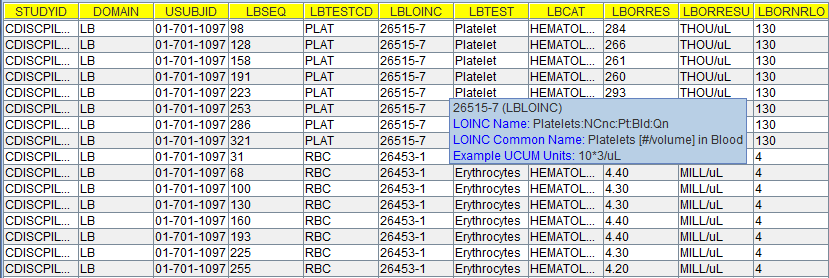LOINC is a worldwide recognized coding system for laboratory tests. It contains over 72,000 codes for lab and vital signs tests, and is used in almost every hospital in the world.
The use of LOINC coding is mandatory in most electronic health record systems and standards for exchange of them, like HL7 CDA. Also, in order to achieve semantic interoperability, the US "Meaningful Use" programm mandates the use of LOINC coding (see e.g. http://blog.healthlanguage.com/blog/bid/220742/LOINC-and-Meaningful-Use).
Still, CDISC refuses to mandate the use LOINC in SDTM LB (laboratory) datasets. Instead, it has developed its own controlled terminology for lab tests, and has published this on the NCI vocabulary website. The latest version of CDISC-CT for lab tests has somewhat more than 2,200 test codes, so it is considerably less detailed and less granular than LOINC. Even worse, the CDISC-CT is just a list, whereas LOINC is a 5-dimensional system.
Essentially, this means that sponsors or their service providers must map whatever they get from the labs to CDISC-CT, which is not only laborious, but also prone to error. A few years ago, a "CDISC LOINC most used codes" list has been published, but is does not contain the CDISC-CT codes, and is also not maintained anymore. Since then, the number of CDISC-CT codes has multiplied.
In the SDTM domain, there is a variable LBLOINC (LOINC code) but is marked as "permissible" and the explanation is: "Dictionary-derived LOINC Code for LBTEST" meaning that the LOINC code should be derived from LBTESTCD/LBTEST, and not the other way around.
So we have the ridiculous situation that the recommended workflow is to derive LBTESTCD/LBTESTD from what the lab is delivering (although the lab itself is using LOINC internally) and then derive LBLOINC from LBTESTCD/LBTEST. You can already guess what will come out of such a workflow.
The fact that LBLOINC is "permissible" has led to the praxis that LOINC codes are omitted from SDTM submissions. I only have seen a small fraction of SDTM submissions where they are provided. This also means that the FDA cannot compare lab test results between different studies and sponsors, as LBTESTCD is not sufficiently granular and is ambiguous.
One of the arguments that people have used against the use of LOINC codes in SDTM is that FDA reviewers cannot deduce information about what the test exactly is just from the LOINC code, which is 4-5 digit number + 1 check digit. Better said: the review tools of the FDA are not connected to a LOINC database for LOINC-code lookups.
Therefore, we have developed a LOINC lookup "RESTful" web service and implemented it in the "Smart Dataset-XML Viewer". It's all still a prototype, but I would like to present the first results anyway.
The development of the prototype took me 3 evenings and a saturday afternoon: one evening for installing the LOINC database on my application/web server, 2 evenings for programming the web service (server side), and one evening for implementing the client side in the "Smart Dataset-XML Viewer". So this is not "rocket science" and I wonder why NCI has not yet implemented such web services for their vocabularies.
Here is a snapshot of a first result:
This is a snapshot of the view of an SDTM-LB dataset using the "Smart Dataset-XML Viewer", containing a LBLOINC column (remark that I moved it to the left just after the LBTESTCD column).
When the user hovers the mouse over an LBLOINC cell, the webservice is triggered, and the code (in this case 26515-7) is send to the LOINC terminology server, and as well the short LOINC name (showing the 5 dimensions), the LOINC "common" name (for "normal" people well- understandable short description) and the example UCUM unit or units that are given in the LOINC database are returned by the web service. This information is then combined, and showed as a tooltip on the cell.
It is important to note that the "Smart Dataset-XML viewer" does NOT have a LOINC database, but it uses a "web service" on a remote server that is generally available to anyone or any application that is connected to the internet.
We are currently developing a series of such web services and will make them generally available. One my my students has already developed a --TESTCD lookup service (see http://cdisc-end-to-end.blogspot.co.at/2014/04/submissions-in-xml-next-step-web.html and http://cdiscguru.blogspot.co.at/2014/07/why-sdtm-should-not-contain-test-as.html) which I still need to implement on a public server, and we will also develop a "UCUM conversion" web service, that e.g. allows to calculate a blood pressure in mm[Hg] from a blood pressure in [psi] "pounds per square inch).
Such web services will hopefully trigger CDISC to adhere to worldwide healthcare accepted semantic standards for laboratory tests and for units, instead of developing their own controlled terminologies for these.
If you would like to try out our LOINC webservice, just send me an e-mail, and I will provide you with the details how to query it.

No comments:
Post a Comment